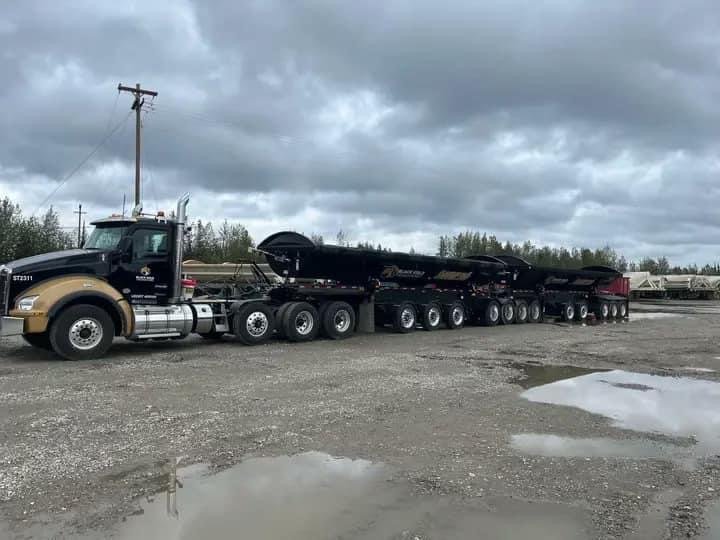Kinross ore-hauling operation would be illegal in 49 states
The 165,000-lb. Kinross mining trucks will carry a weight that is legal in Alaska and illegal in every other state.
The reason the proposed Kinross loads are legal in Alaska is that almost any load is legal in Alaska no matter how heavy, if there are enough axles on the truck to reduce the per-axle weight.
That’s why the Kinross trucks have 16 axles.
“Alaska is unique in that it does not have a stated gross vehicle weight limit,” the U.S. Department of Transportation says in this analysis of the 50 states.
In every other state there is a maximum gross vehicle weight in state law or regulation. In most states, the rules would require that tens of thousands of pounds be dropped from these trucks.
The maximum gross vehicle weight on the Interstate highway system has long been 80,000 pounds. Here is the state-by-state rundown. The limits are in place for safety and for preventing road damage.
Nine states have an 80,000-pound limit. Others have higher limits, but there are restrictions on where overweight loads are permitted. In Michigan, which has the highest weight limit in the country, the Kinross trucks would still be 1,000 pounds overweight.
The approach used in Alaska deems that trucks with a gross vehicle weight of 165,000 pounds are legal because of those 16 axles.
The Alaska loophole, which I think may be related to the so-called grandfather rule about loads on federal highways from the 1950s, may have made sense in 1975 during trans-Alaska pipeline construction, but not now and not for trucks of this length and weight, that are going to be on the road all the time, winter and summer in daylight and darkness for years to come.
(A separate question—regarding the state regulation that bans these trucks from Peger Road and part of the Johansen Expressway because of their length—will be dealt with in a future column.)
Kinross and the Dunleavy administration, which act like business partners, mention that the loads are legal every chance they get. But are these loads safe?
The state hasn’t bothered to investigate, preferring to just say they are legal.
I understand why Kinross is silent about the weight problem. The company stands to make hundreds of millions, perhaps close to $1 billion over five years, and this project is a high priority. It’s not going to endanger those potential profits by adding more safety questions to the debate. Sixteen axles will take care of everything.
Yet the perception by Alaska drivers of what is safe is not going to be the same as that of J. Paul Rollinson, the president of Kinross, who made $6.5 million last year, has $11 million in stock and won’t be sharing the roads with the Kinross fleet because he’s in Toronto.
What I don’t accept is that state agencies—taking a cue from Dunleavy—have taken a vow of silence about the safety of the Kinross truck configuration, with round-the-clock operations scheduled to continue for years.
What does it say about the Alaska rules that trucks with these loads would not be allowed in other states and yet they are legal here, where roads take a beating from much lighter trucks?
Our legislators have been ineffective, inattentive or simply have bought into the Kinross lobby campaign swallowed by Dunleavy with no questions asked.
The words “this is legal” are repeatedly used by the state to imply that “this is safe” without anyone in authority ever being forced to say or write those three little words.
If it’s legal, it must be safe, right? That is the message we get from the state.
The Dunleavy administration is relying on the assumption that people will believe that what is legal must be safe, with the public blindly trusting that someone has looked at all this, unaware that no one has done so.
The transportation department, the public safety department, the law department and the governor are hiding behind “this is legal,” having never tried to demonstrate that “this is safe.” We don’t know what might be done to make this operation safer because the state has not bothered to find out.
That the state has no legal GVW limit is hardly grounds to conclude that a GVW deemed illegal and unsafe in 49 states is legal and safe here.
Yet that is what we are being told by Dunleavy. The Kinross plan may be legal, but there is no reason to believe it is safe.
Your contributions help support independent analysis and political commentary by Alaska reporter and author Dermot Cole. Thank you for reading and for your support. Either click here to use PayPal or send checks to: Dermot Cole, Box 10673, Fairbanks, AK 99710-0673.

